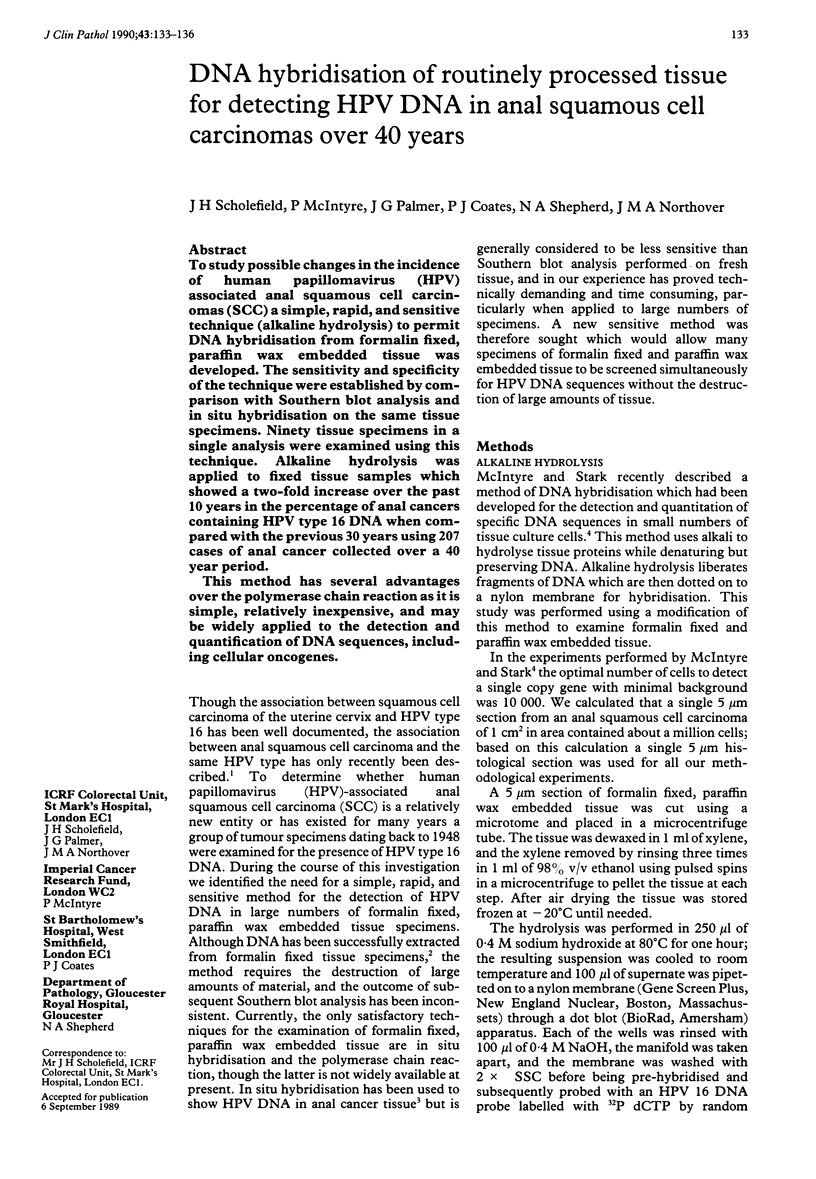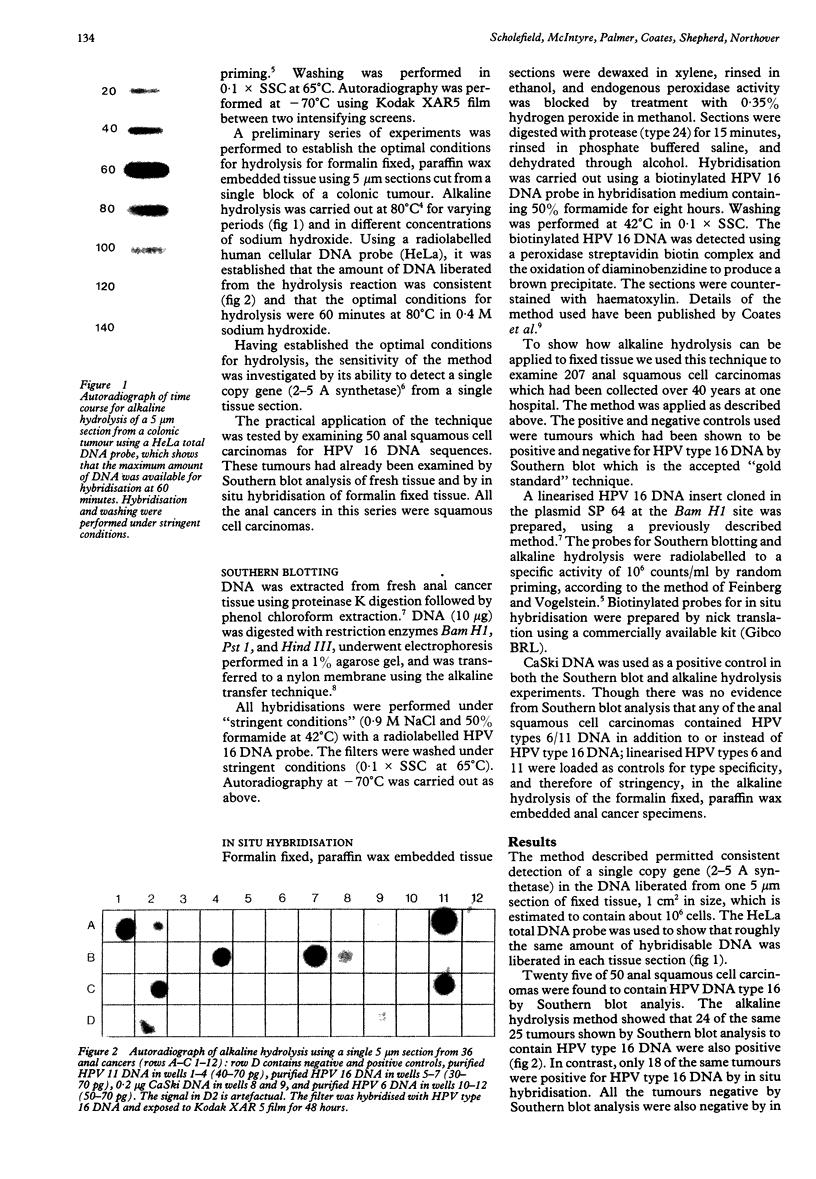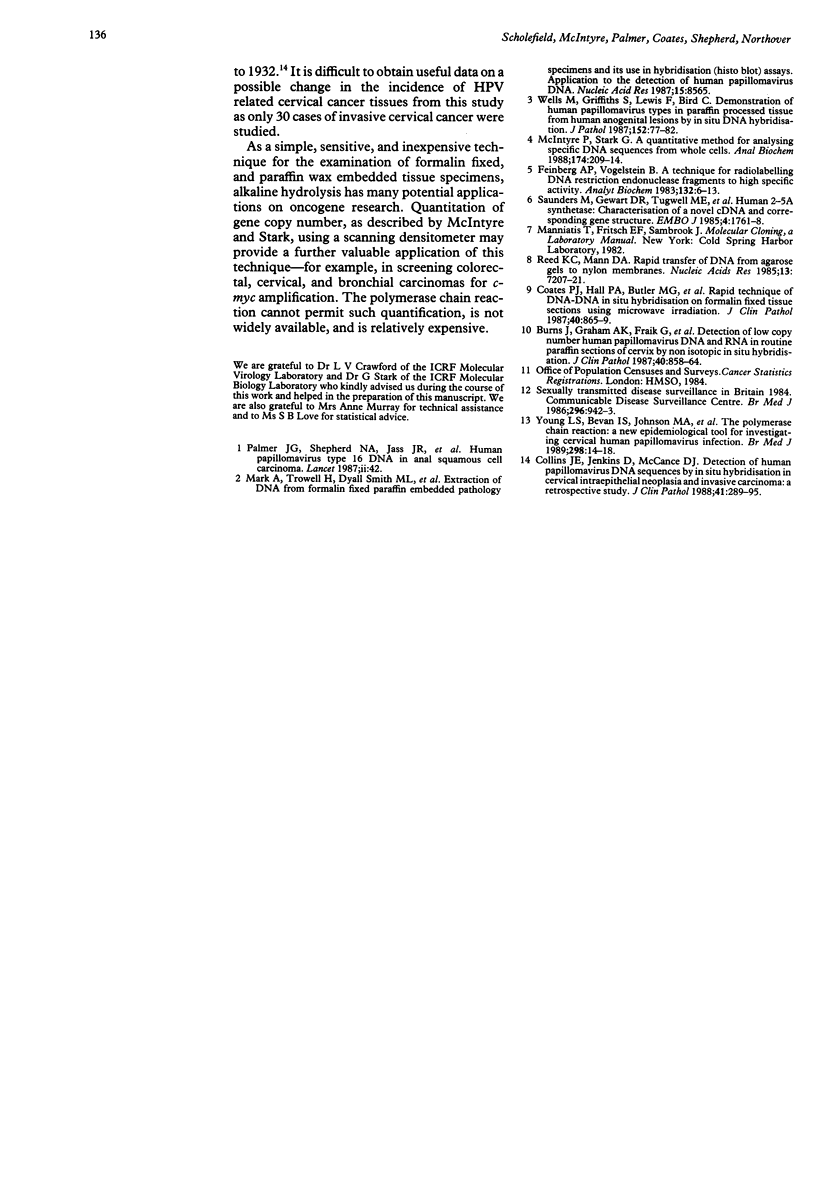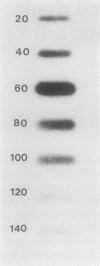Abstract
To study possible changes in the incidence of human papillomavirus (HPV) associated anal squamous cell carcinomas (SCC) a simple, rapid, and sensitive technique (alkaline hydrolysis) to permit DNA hybridisation from formalin fixed, paraffin wax embedded tissue was developed. The sensitivity and specificity of the technique were established by comparison with Southern blot analysis and in situ hybridisation on the same tissue specimens. Ninety tissue specimens in a single analysis were examined using this technique. Alkaline hydrolysis was applied to fixed tissue samples which showed a two-fold increase over the past 10 years in the percentage of anal cancers containing HPV type 16 DNA when compared with the previous 30 years using 207 cases of anal cancer collected over a 40 year period. This method has several advantages over the polymerase chain reaction as it is simple, relatively inexpensive, and may be widely applied to the detection and quantification of DNA sequences, including cellular oncogenes.
Full text
PDF



Images in this article
Selected References
These references are in PubMed. This may not be the complete list of references from this article.
- Burns J., Graham A. K., Frank C., Fleming K. A., Evans M. F., McGee J. O. Detection of low copy human papilloma virus DNA and mRNA in routine paraffin sections of cervix by non-isotopic in situ hybridisation. J Clin Pathol. 1987 Aug;40(8):858–864. doi: 10.1136/jcp.40.8.858. [DOI] [PMC free article] [PubMed] [Google Scholar]
- Coates P. J., Hall P. A., Butler M. G., D'Ardenne A. J. Rapid technique of DNA-DNA in situ hybridisation on formalin fixed tissue sections using microwave irradiation. J Clin Pathol. 1987 Aug;40(8):865–869. doi: 10.1136/jcp.40.8.865. [DOI] [PMC free article] [PubMed] [Google Scholar]
- Collins J. E., Jenkins D., McCance D. J. Detection of human papillomavirus DNA sequences by in situ DNA-DNA hybridisation in cervical intraepithelial neoplasia and invasive carcinoma: a retrospective study. J Clin Pathol. 1988 Mar;41(3):289–295. doi: 10.1136/jcp.41.3.289. [DOI] [PMC free article] [PubMed] [Google Scholar]
- Feinberg A. P., Vogelstein B. A technique for radiolabeling DNA restriction endonuclease fragments to high specific activity. Anal Biochem. 1983 Jul 1;132(1):6–13. doi: 10.1016/0003-2697(83)90418-9. [DOI] [PubMed] [Google Scholar]
- Mark A., Trowell H., Dyall-Smith M. L., Dyall-Smith D. J. Extraction of DNA from formalin-fixed paraffin-embedded pathology specimens and its use in hybridization (histo-blot) assays. Application to the detection of human papillomavirus DNA. Nucleic Acids Res. 1987 Oct 26;15(20):8565–8565. doi: 10.1093/nar/15.20.8565. [DOI] [PMC free article] [PubMed] [Google Scholar]
- McIntyre P., Stark G. R. A quantitative method for analyzing specific DNA sequences directly from whole cells. Anal Biochem. 1988 Oct;174(1):209–214. doi: 10.1016/0003-2697(88)90537-4. [DOI] [PubMed] [Google Scholar]
- Palmer J. G., Shepherd N. A., Jass J. R., Crawford L. V., Northover J. M. Human papillomavirus type 16 DNA in anal squamous cell carcinoma. Lancet. 1987 Jul 4;2(8549):42–42. doi: 10.1016/s0140-6736(87)93075-3. [DOI] [PubMed] [Google Scholar]
- Reed K. C., Mann D. A. Rapid transfer of DNA from agarose gels to nylon membranes. Nucleic Acids Res. 1985 Oct 25;13(20):7207–7221. doi: 10.1093/nar/13.20.7207. [DOI] [PMC free article] [PubMed] [Google Scholar]
- Saunders M. E., Gewert D. R., Tugwell M. E., McMahon M., Williams B. R. Human 2-5A synthetase: characterization of a novel cDNA and corresponding gene structure. EMBO J. 1985 Jul;4(7):1761–1768. doi: 10.1002/j.1460-2075.1985.tb03848.x. [DOI] [PMC free article] [PubMed] [Google Scholar]
- Wells M., Griffiths S., Lewis F., Bird C. C. Demonstration of human papillomavirus types in paraffin processed tissue from human ano-genital lesions by in-situ DNA hybridisation. J Pathol. 1987 Jun;152(2):77–82. doi: 10.1002/path.1711520203. [DOI] [PubMed] [Google Scholar]
- Young L. S., Bevan I. S., Johnson M. A., Blomfield P. I., Bromidge T., Maitland N. J., Woodman C. B. The polymerase chain reaction: a new epidemiological tool for investigating cervical human papillomavirus infection. BMJ. 1989 Jan 7;298(6665):14–18. doi: 10.1136/bmj.298.6665.14. [DOI] [PMC free article] [PubMed] [Google Scholar]




